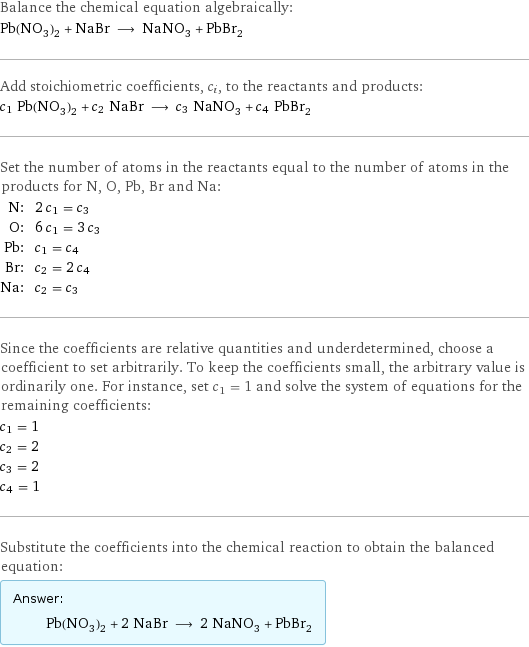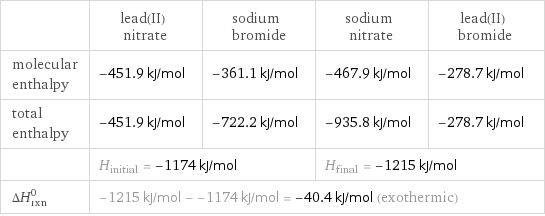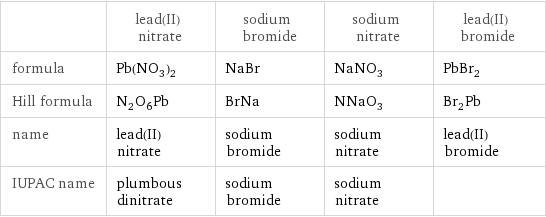Input interpretation

Pb(NO_3)_2 lead(II) nitrate + NaBr sodium bromide ⟶ NaNO_3 sodium nitrate + PbBr_2 lead(II) bromide
Balanced equation

Balance the chemical equation algebraically: Pb(NO_3)_2 + NaBr ⟶ NaNO_3 + PbBr_2 Add stoichiometric coefficients, c_i, to the reactants and products: c_1 Pb(NO_3)_2 + c_2 NaBr ⟶ c_3 NaNO_3 + c_4 PbBr_2 Set the number of atoms in the reactants equal to the number of atoms in the products for N, O, Pb, Br and Na: N: | 2 c_1 = c_3 O: | 6 c_1 = 3 c_3 Pb: | c_1 = c_4 Br: | c_2 = 2 c_4 Na: | c_2 = c_3 Since the coefficients are relative quantities and underdetermined, choose a coefficient to set arbitrarily. To keep the coefficients small, the arbitrary value is ordinarily one. For instance, set c_1 = 1 and solve the system of equations for the remaining coefficients: c_1 = 1 c_2 = 2 c_3 = 2 c_4 = 1 Substitute the coefficients into the chemical reaction to obtain the balanced equation: Answer: | | Pb(NO_3)_2 + 2 NaBr ⟶ 2 NaNO_3 + PbBr_2
Structures

+ ⟶ +
Names

lead(II) nitrate + sodium bromide ⟶ sodium nitrate + lead(II) bromide
Reaction thermodynamics
Enthalpy

| lead(II) nitrate | sodium bromide | sodium nitrate | lead(II) bromide molecular enthalpy | -451.9 kJ/mol | -361.1 kJ/mol | -467.9 kJ/mol | -278.7 kJ/mol total enthalpy | -451.9 kJ/mol | -722.2 kJ/mol | -935.8 kJ/mol | -278.7 kJ/mol | H_initial = -1174 kJ/mol | | H_final = -1215 kJ/mol | ΔH_rxn^0 | -1215 kJ/mol - -1174 kJ/mol = -40.4 kJ/mol (exothermic) | | |
Equilibrium constant
![Construct the equilibrium constant, K, expression for: Pb(NO_3)_2 + NaBr ⟶ NaNO_3 + PbBr_2 Plan: • Balance the chemical equation. • Determine the stoichiometric numbers. • Assemble the activity expression for each chemical species. • Use the activity expressions to build the equilibrium constant expression. Write the balanced chemical equation: Pb(NO_3)_2 + 2 NaBr ⟶ 2 NaNO_3 + PbBr_2 Assign stoichiometric numbers, ν_i, using the stoichiometric coefficients, c_i, from the balanced chemical equation in the following manner: ν_i = -c_i for reactants and ν_i = c_i for products: chemical species | c_i | ν_i Pb(NO_3)_2 | 1 | -1 NaBr | 2 | -2 NaNO_3 | 2 | 2 PbBr_2 | 1 | 1 Assemble the activity expressions accounting for the state of matter and ν_i: chemical species | c_i | ν_i | activity expression Pb(NO_3)_2 | 1 | -1 | ([Pb(NO3)2])^(-1) NaBr | 2 | -2 | ([NaBr])^(-2) NaNO_3 | 2 | 2 | ([NaNO3])^2 PbBr_2 | 1 | 1 | [PbBr2] The equilibrium constant symbol in the concentration basis is: K_c Mulitply the activity expressions to arrive at the K_c expression: Answer: | | K_c = ([Pb(NO3)2])^(-1) ([NaBr])^(-2) ([NaNO3])^2 [PbBr2] = (([NaNO3])^2 [PbBr2])/([Pb(NO3)2] ([NaBr])^2)](../image_source/7788232113812e04bab7d927f6cb846d.png)
Construct the equilibrium constant, K, expression for: Pb(NO_3)_2 + NaBr ⟶ NaNO_3 + PbBr_2 Plan: • Balance the chemical equation. • Determine the stoichiometric numbers. • Assemble the activity expression for each chemical species. • Use the activity expressions to build the equilibrium constant expression. Write the balanced chemical equation: Pb(NO_3)_2 + 2 NaBr ⟶ 2 NaNO_3 + PbBr_2 Assign stoichiometric numbers, ν_i, using the stoichiometric coefficients, c_i, from the balanced chemical equation in the following manner: ν_i = -c_i for reactants and ν_i = c_i for products: chemical species | c_i | ν_i Pb(NO_3)_2 | 1 | -1 NaBr | 2 | -2 NaNO_3 | 2 | 2 PbBr_2 | 1 | 1 Assemble the activity expressions accounting for the state of matter and ν_i: chemical species | c_i | ν_i | activity expression Pb(NO_3)_2 | 1 | -1 | ([Pb(NO3)2])^(-1) NaBr | 2 | -2 | ([NaBr])^(-2) NaNO_3 | 2 | 2 | ([NaNO3])^2 PbBr_2 | 1 | 1 | [PbBr2] The equilibrium constant symbol in the concentration basis is: K_c Mulitply the activity expressions to arrive at the K_c expression: Answer: | | K_c = ([Pb(NO3)2])^(-1) ([NaBr])^(-2) ([NaNO3])^2 [PbBr2] = (([NaNO3])^2 [PbBr2])/([Pb(NO3)2] ([NaBr])^2)
Rate of reaction
![Construct the rate of reaction expression for: Pb(NO_3)_2 + NaBr ⟶ NaNO_3 + PbBr_2 Plan: • Balance the chemical equation. • Determine the stoichiometric numbers. • Assemble the rate term for each chemical species. • Write the rate of reaction expression. Write the balanced chemical equation: Pb(NO_3)_2 + 2 NaBr ⟶ 2 NaNO_3 + PbBr_2 Assign stoichiometric numbers, ν_i, using the stoichiometric coefficients, c_i, from the balanced chemical equation in the following manner: ν_i = -c_i for reactants and ν_i = c_i for products: chemical species | c_i | ν_i Pb(NO_3)_2 | 1 | -1 NaBr | 2 | -2 NaNO_3 | 2 | 2 PbBr_2 | 1 | 1 The rate term for each chemical species, B_i, is 1/ν_i(Δ[B_i])/(Δt) where [B_i] is the amount concentration and t is time: chemical species | c_i | ν_i | rate term Pb(NO_3)_2 | 1 | -1 | -(Δ[Pb(NO3)2])/(Δt) NaBr | 2 | -2 | -1/2 (Δ[NaBr])/(Δt) NaNO_3 | 2 | 2 | 1/2 (Δ[NaNO3])/(Δt) PbBr_2 | 1 | 1 | (Δ[PbBr2])/(Δt) (for infinitesimal rate of change, replace Δ with d) Set the rate terms equal to each other to arrive at the rate expression: Answer: | | rate = -(Δ[Pb(NO3)2])/(Δt) = -1/2 (Δ[NaBr])/(Δt) = 1/2 (Δ[NaNO3])/(Δt) = (Δ[PbBr2])/(Δt) (assuming constant volume and no accumulation of intermediates or side products)](../image_source/c465c57312cad3b01e2d31b371ca9942.png)
Construct the rate of reaction expression for: Pb(NO_3)_2 + NaBr ⟶ NaNO_3 + PbBr_2 Plan: • Balance the chemical equation. • Determine the stoichiometric numbers. • Assemble the rate term for each chemical species. • Write the rate of reaction expression. Write the balanced chemical equation: Pb(NO_3)_2 + 2 NaBr ⟶ 2 NaNO_3 + PbBr_2 Assign stoichiometric numbers, ν_i, using the stoichiometric coefficients, c_i, from the balanced chemical equation in the following manner: ν_i = -c_i for reactants and ν_i = c_i for products: chemical species | c_i | ν_i Pb(NO_3)_2 | 1 | -1 NaBr | 2 | -2 NaNO_3 | 2 | 2 PbBr_2 | 1 | 1 The rate term for each chemical species, B_i, is 1/ν_i(Δ[B_i])/(Δt) where [B_i] is the amount concentration and t is time: chemical species | c_i | ν_i | rate term Pb(NO_3)_2 | 1 | -1 | -(Δ[Pb(NO3)2])/(Δt) NaBr | 2 | -2 | -1/2 (Δ[NaBr])/(Δt) NaNO_3 | 2 | 2 | 1/2 (Δ[NaNO3])/(Δt) PbBr_2 | 1 | 1 | (Δ[PbBr2])/(Δt) (for infinitesimal rate of change, replace Δ with d) Set the rate terms equal to each other to arrive at the rate expression: Answer: | | rate = -(Δ[Pb(NO3)2])/(Δt) = -1/2 (Δ[NaBr])/(Δt) = 1/2 (Δ[NaNO3])/(Δt) = (Δ[PbBr2])/(Δt) (assuming constant volume and no accumulation of intermediates or side products)
Chemical names and formulas

| lead(II) nitrate | sodium bromide | sodium nitrate | lead(II) bromide formula | Pb(NO_3)_2 | NaBr | NaNO_3 | PbBr_2 Hill formula | N_2O_6Pb | BrNa | NNaO_3 | Br_2Pb name | lead(II) nitrate | sodium bromide | sodium nitrate | lead(II) bromide IUPAC name | plumbous dinitrate | sodium bromide | sodium nitrate |
Substance properties

| lead(II) nitrate | sodium bromide | sodium nitrate | lead(II) bromide molar mass | 331.2 g/mol | 102.89 g/mol | 84.994 g/mol | 367 g/mol phase | solid (at STP) | solid (at STP) | solid (at STP) | solid (at STP) melting point | 470 °C | 755 °C | 306 °C | 371 °C boiling point | | 1396 °C | | 892 °C density | | 3.2 g/cm^3 | 2.26 g/cm^3 | 6.66 g/cm^3 solubility in water | | soluble | soluble | dynamic viscosity | | | 0.003 Pa s (at 250 °C) | 0.0088 Pa s (at 382 °C) odor | odorless | | |
Units
